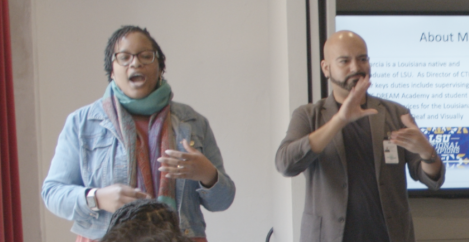Home » Resources » Access & Accommodations » Testing Accommodations » Proactive Planning
Proactive Planning
A proactive approach to creating campus-wide access for deaf students provides better outcomes for those students while also benefiting institutions in a variety of ways, including cost-effectiveness and legal protection.
Initial Meeting
When scheduling an initial meeting with a deaf student, ask about their communication preferences for the meeting so that appropriate accommodations can be scheduled.
Plan to review with the student their past accommodation preferences and what they think would be the best fit for the upcoming semester. Accommodation usage can change dramatically for deaf students who are moving from a K-12 environment to a post-secondary setting. Larger class sizes, an increased number of speakers, and a faster pace can mean that different accommodations are required to achieve effective communication, including accommodations that the student has not used in the past.
Policies and Procedures

Developing policies and procedures that outline how access will be provided through the disability support services office is an important step in proactive planning. By having clear policies and procedures in place for students and service providers, institutions can have a better chance of avoiding misunderstandings and negative consequences. Some things to consider:
- How will students request accommodations and how much advance notice will be required?
- How will the institution handle last-minute requests?
- What happens if a student receiving access services (e.g., interpreters) has excessive absences?
- What is the process if a student prefers a different interpreter or speech-to-text provider than the one assigned?
- How will student complaints be addressed?
Sign Language Interpreters
Developing policies and procedures that outline how access will be provided through the disability support services office is an important step in proactive planning. By having clear policies and procedures in place for students and service providers, institutions can have a better chance of avoiding misunderstandings and negative consequences. Some things to consider:
- How will students request accommodations and how much advance notice will be required?
- How will the institution handle last-minute requests?
- What happens if a student receiving access services (e.g., interpreters) has excessive absences?
- What is the process if a student prefers a different interpreter or speech-to-text provider than the one assigned?
- How will student complaints be addressed?

There are many other possible considerations not listed here; our Help Team is available for consultation for further discussion on policies and processes for proactive planning.
Speech-to-Text Providers

Speech-to-text services is an umbrella term that covers real-time access to information via the written word. The two basic categories are verbatim (CART) and meaning-for-meaning (C-Print© and TypeWell). Maintaining a list of these providers allows for greater flexibility in scheduling services. In addition, it can be helpful for institutions to develop policies on how the transcripts from the service provider will be used. Consider these questions:
- Will transcripts generated by the captionist be provided to the student?
- Will faculty or other campus staff be able to utilize these transcripts?
Finally, institutions are responsible for hiring qualified speech-to-text providers to meet the demands of the higher education setting. The steps involved with hiring qualified speech-to-text providers can be found in Hiring Qualified Speech-to-Text Service Providers.
Captioned Media
Offline or post-production captioning has become a hot topic on many campuses. A video must have verbatim, time-synced captions to be accessible. All videos should be captioned. This includes course-based content, but also media on the institution’s website, including anything that is streamed for public access. Many institutions are moving toward the practice of captioning all media used in courses, whether or not a deaf student is registered. This practice prevents incidents in which the media lacks necessary captions, and decreases the need for last-minute requests for captioned material. In addition, some institutions have policies in place that require all media purchases to be accessible to students with disabilities.
To learn more about offline or post-production captioning, refer to our Captioned Media page.






